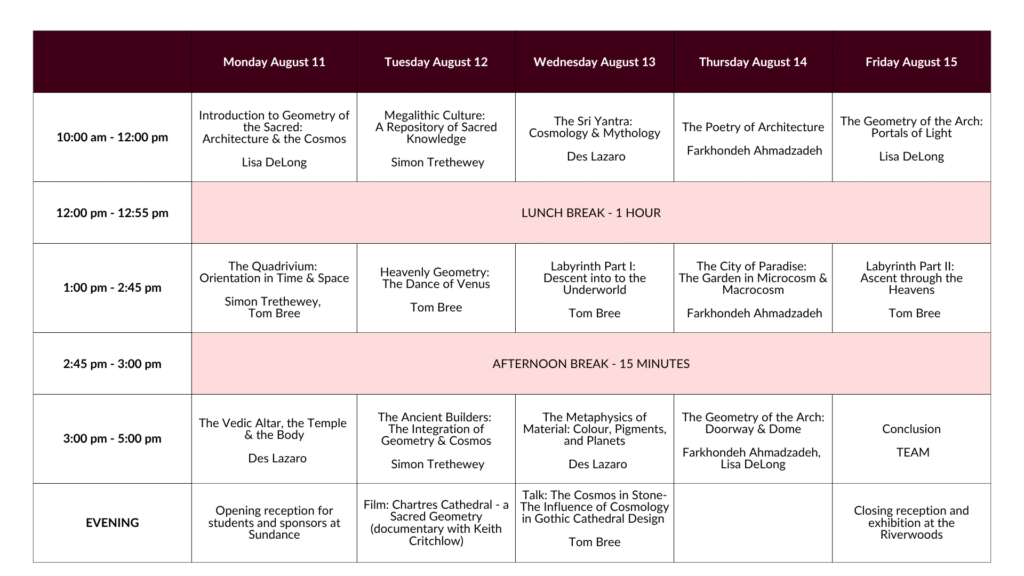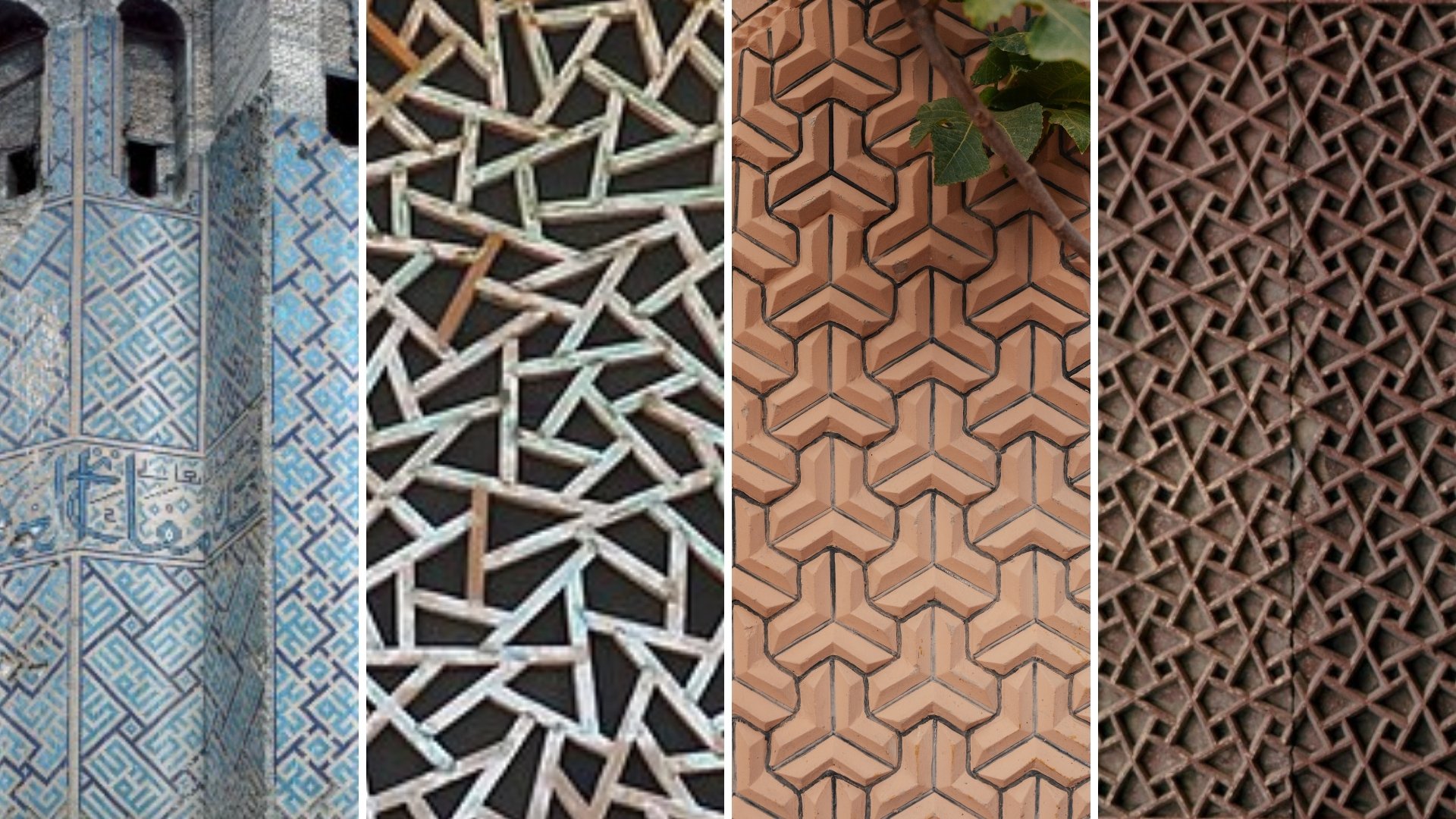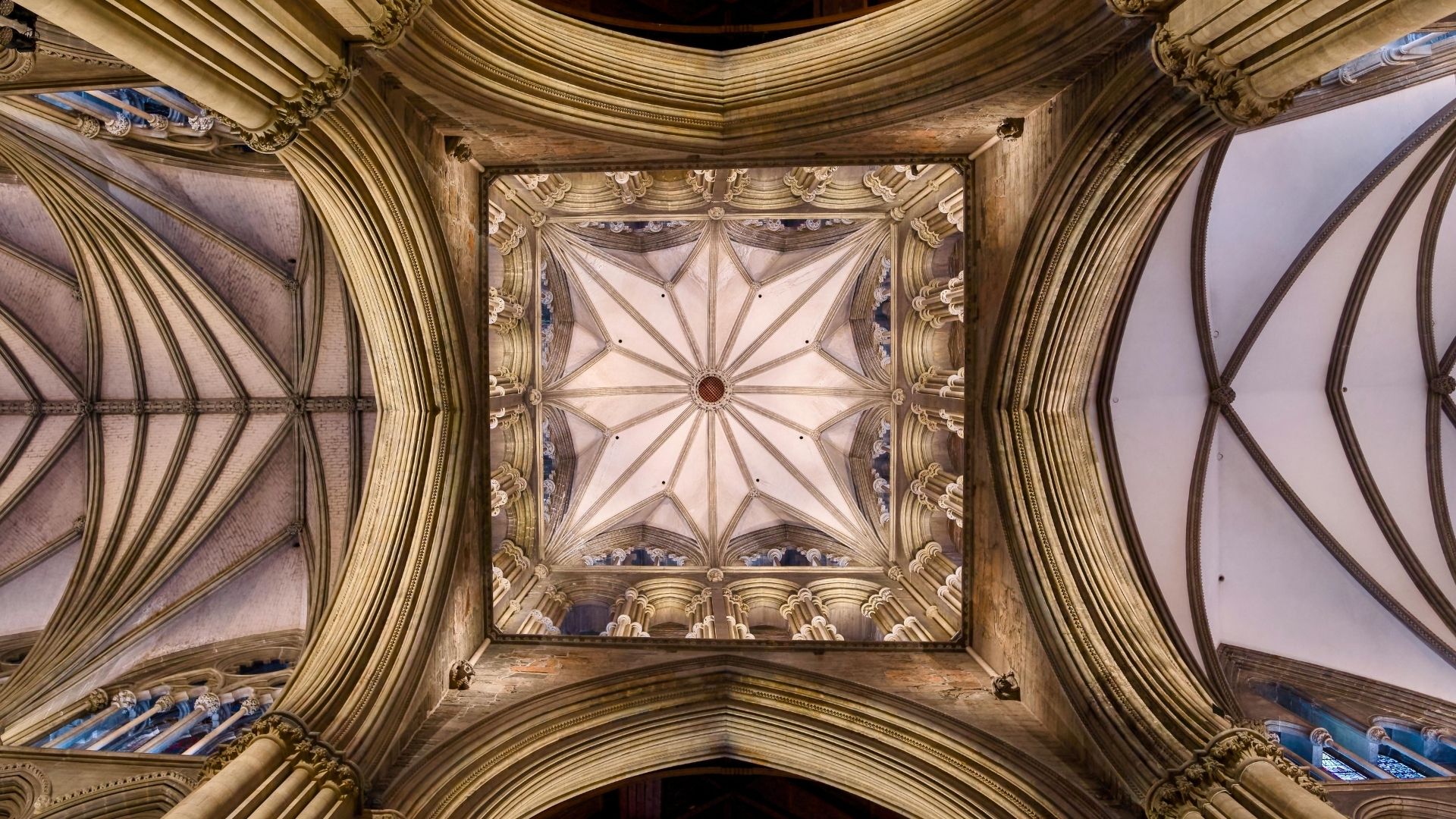About
The King’s Foundation is pleased to announce the 2025 Geometry Summer School. This year for the very first time, the Geometry Summer School will be taking place in North America. Join a team of expert tutors in the stunning Rocky Mountains for an intensive week investigating the geometry and cosmology of sacred architecture.
The Summer School programme will include practical geometry sessions, hand drawing and 3D construction activities, and illustrated presentations on sacred buildings from a variety of spiritual traditions including megalithic structures, the Great Pyramid, mosques, cathedrals, and Hindu temples.
Session Descriptions
Our five tutors will be conducting 15 different sessions throughout the week, interweaving a variety of approaches to the geometry of sacred architecture. Each of our tutors has provided a brief summary of the topics they will be exploring in their sessions:
Simon Trethewey
From the beginning, humanity has looked to the sky, fascinated by the cycles of sun, moon, and stars. These cosmic patterns have inspired some of the most ancient constructions of sacred space as can be seen in monuments such as Stonehenge, the Serpent Mound, and the stones of Carnac.
Simon Trethewey will lead summer school participants throughthe geometrical underpinnings of megalithic monuments. These structures, oriented to the heavens, embody proportional dimension, ancient mathematical knowledge, metrology, and cosmic harmonics.
Throughout the week, we will be exploring these fields through hand-drawn construction, measured construction on the ground, and comparisons within ancient cultures and the natural world.
Dr Desmond Lazaro
Dr Lazaro will lead participants in an exploration of the Vedic Shri Yantra diagram and its relation to Hindu mythology, the Vedic fire altar and the origins of temple architecture.
His presentation is part of an ongoing research project in collaboration with mathematician Professor Nick Tisdel: University of New South Wales and Art Gallery of New South Wales. This research suggests a connection between the Vedic fire altar brick (the backbone of later temple architecture) and the Precession of the Equinoxes. Precession is the Earth’s slow rotational wobble as it shifts westward along the ecliptic cycle.
This cosmic process lies at the heart of many world creation myths; in the Vedic tradition it is known as Samudra Manthan (The Churning of the Ocean of Milk). Through a series of short talks, interactive exercises, drawing sessions and pigment demonstrations, we hope to unpack the myth and perhaps deepen our connection to these cosmic cycles, the heavens, and more importantly ourselves.
Tom Bree
Tom Bree will explore the design and use of sacred architecture as an internal world which embodies the journey of the soul. Such a journey begins from the Earth, passes through the Underworld, and finally ascends upwards through the Heavens.
Sacred architecture will be approached through the Quadrivium (Arithmetic, Geometry, Music, Cosmology). Practical investigations — tabletop hand-drawings and full-scale recreations — will engage with labyrinths and the first English Gothic Cathedral in the city of Wells.
Farkhondeh Ahmadzadeh
“Oh dear soul, you and I resemble a compass / Although divided in two, we are of one body / We are following a point like a compass / But in the end we will unify.”
-Abu Saeed Abul-Khayr, 10th century Persian Sufi poet
Geometry and proportion are integral to the design of mosques. Farkhondeh Ahmadzadeh will lead participants through an exploration of the geometries found within Iranian mosques, focusing on their layout, and the formation of arches and dome structures by complex interlocking of circles.
The symbolism of the Garden of Paradise is also reflected in these beautiful spaces. We will delve into Persian poetry and its integration into sacred architecture. We will discover how poetry, gardens, and patterns in tiles and brickwork are intricately woven together in these buildings.
Dr Lisa DeLong
he architect’s traditional tools have been used since ancient times. When wielded with knowledge, skill, and wisdom, they bring harmony and proportion to the work. Dr DeLong will introduce their use and symbolism, exploring how they have been fundamental to the development of art, architecture, and geometric knowledge in a myriad of cultures.
The delicate tracery of gothic architecture is one area where the architect’s mastery of compass and square reached particular heights. Participants in the summer school will engage with this visual language, building a vocabulary of shapes and forms that can be recombined in a multitude of ways to generate uncountable geometric patterns.
Timetable

Key Information
-
Who is this course for?
All levels of ability and experience are welcome. You must be aged 18 or over to participate in our programmes.
-
What days/times do I attend?
Monday – Friday, 11 – 15 August 2025
-
Where will the Summer School take place?
This year’s workshop will take place at the Riverwoods in Provo, Utah at the base of the Wasatch Mountains near the entrance to Provo Canyon.
Venue:
One Enterprises
5005 N University Ave
Provo, Utah 84604
USASee map.
-
Venue Accessibility
- Our venue has step-free access throughout
- Accessible toilets are available
Please email us if you have any accessibility concerns and needs. Your email will be treated with sensitivity and confidentiality.
-
What materials should I bring?
Most materials will be provided, but we do strongly recommend that participants bring their own favourite geometry drawing and note-taking tools.
Specific recommendations will be made in the coming weeks.
-
Are accomodation and meals included?
Meals and accommodation are not included in the cost of the summer school.
Biographies
Lisa DeLong
Dr Lisa DeLong completed her doctoral studies at the School in 2007 investigating the principles of geometric design in Islamic and Western traditions. She is the author of Curves: Flowers, Foliates and Flourishes in the Formal Decorative Arts. An avid painter, Lisa is also Outreach Programme Manager for the School, designing and conducting educational workshops internationally.
Farkhondeh Ahmadzadeh
Farkhondeh Ahmadzadeh is an Iranian artist based in London. Her work explores the disciplines of Persian poetry manuscripts, sacred geometry and Persian miniatures. She has worked both as an academic and an artist in Iran, America and Europe. For the last 20 years, Farkhondeh has regularly spent time living and studying under calligraphy masters in Iran. She graduated with distinction from The King’s Foundation School of Traditional Arts’ MA programme in 2011 and was awarded the Jerwood prize for Islamic traditional art. She now works at the School as the MA Deputy Director of the Studies.
Tom Bree
Tom Bree is a geometer-artist, teacher and writer. He completed his M.A. at the School in 2003 and has since been researching and teaching in the area of geometry and symbolism. Tom has been teaching on the Open and M.A. programmes since 2008 and also organises his own geometry courses both in the UK and abroad. Tom has recently published, The Cosmos in Stone: Sacred Geometry of a Master Mason, a book containing 10 years of research concerning the use of the Quadrivial arts in the design of English Gothic cathedrals.
Desmond Lazaro
Dr Desmond Lazaro was born in Leeds (1968). Initial degree in painting at the University of Central Lancashire (1990). Commonwealth Scholarship to India, post graduate University of Baroda (1991-94). Second post-grad and PhD in London, subsequently published as Materials, Methods & Symbolism in the Pichhvai Painting Tradition of Rajasthan (Mapin 2005). Since 2008 Lazaro has exhibited internationally, contributed to numerous publications, lectures and seminars. He is currently preparing for Avatar at exhibition at AGNSW, Sydney in 2026, with the ‘Churning of the Ocean’ project.
Simon Trethewey
Simon Trethewey is the former Director of Studies for the MA program at The King’s Foundation School of Traditional Arts. He studied at the Royal College of Art in the Visual Islamic and Traditional Arts department with Professor Keith Critchlow and Paul Marchant, graduating with Distinction in 1991. Using the universal language of geometry as source and inspiration, Simon worked for many years as a painter in the medium of egg tempera on gesso. He also works in ceramics and stained glass, designing for a contemporary architectural context. He has exhibited internationally, notably with the British Council in New Delhi and Mumbai where he was a Commonwealth Scholar. Simon’s recent research explores the cosmological proportions found in ancient cultures. This geometry’s timeless relevance forms the basis of teaching materials presented as part of the MA programme. In the practice of traditional arts, these same principles are essential components of design.
FAQs
Do you offer concessions?
Yes, we offer concessions for Seniors/60+, full-time students and people who are unemployed/in receipt of benefits.
Concessions cannot be applied in retrospect. To receive a concession, please apply via our online form. We will then send you a discount code to use when booking your space.
Terms & Conditions
The School reserves the right to discontinue or suspend a Course up to fourteen (14) calendar days before the advertised start date of the Course. This course requires a minimum number of enrollments to run.
Our normal terms and conditions apply.



